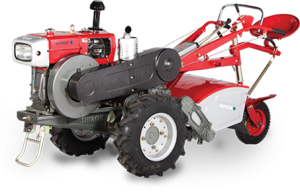Indian agricultural sector still lags (about 40% mechanized) and requires an increase in the penetration of farm equipments. There is direct relationship between the productivity level and farm mechanisation. Countries with higher levels of farm mechanisation are able to increase their productivity and therefore are better equipped to meet their demand factors. In an exclusive interview to AgriNation, Managing Director of Shrachi Agro, Mr Ravi Todi talks about the future of agriculture machinery in India.
1. How do you see evolution of Indian agriculture machinery industry in the country?
Shortage of farm labour and the need to enhance farm productivity are among the main reasons for increasing farm mechanisation in India. Across the world, other farm machinery outsells tractors and power tillers but the availability of abundant and cheap labour has largely confined farm mechanisation in India to tractors and power tillers. Penetration of tractors in India is higher in northern India, mainly Punjab, UP and Haryana. On the other hand, the penetration of power tillers in India is higher in southern and eastern India on account of the small size of land holdings per farmer in these respective regions.
While tractors and power tillers still outsell other farm equipment like paddy transplanters and combine harvesters, the gap has closed in recent years. It is because of rural youth population is migrating to cities in search of better paying jobs in services and factories. This is creating a big market for specialised machineries, such as threshers, rotavator, transplanters, reapers, zero till drills, laser levellers and power weeders, the size of which is worth Rs 32,000 crores and it is growing at an annual rate of 5-8%. It is estimated to touch Rs 37,000-40,000 crores level in coming 3-5 years.
The government too is promoting ‘balanced farm mechanisation’ by providing subsidy on various equipments and by supporting bulk buying through front-end agencies. The government also provides credit and financial assistance to support local manufacturing of farm mechanisation equipment. Both Central and State governments have been increasing its focus to develop farm mechanization in the Himalayan and North Eastern region where the Centre alone has allotted Rs. 3700 Cr for next five years starting FY 16-17. This would push the demand for machines such as power weeder, sprayers, and other smaller implements suitable for hilly and terrace cultivation.
Custom-hiring centres are also becoming popular across the country where Centre and State governments are incentivizing manufacturers and private entrepreneurs under PPP mode (Part of Sub-Mission on Agriculture Mechanization – SMAM) to create farm machinery banks and high-tech productive equipment hub so that our farmers are not deprived of the benefits of large machines and implements such as sugarcane harvester, boom sprayers, etc. Further to reduce dependence of Indian agriculture on monsoons a long term irrigation fund will be created in NABARD with an initial corpus of about Rs 20,000 crores as envisioned in the Union budget 2016-17 which will create substantial demand for micro irrigation systems.

2.Why the level of mechanisation in Indian agriculture is still quite low compared with other countries?
While farm mechanisation in India has made strong strides, there is much that is needed. Countries such as United States, Canada and some European countries are completely mechanised (at least more than 95%). China and Japan (more than 60% mechanized) have also seen higher penetration of farm machineries. As compared to these, Indian agricultural sector still lags (about 40% mechanized) and requires an increase in the penetration of farm equipments. There is direct relationship between the productivity level and farm mechanisation. Countries with higher levels of farm mechanisation are able to increase their productivity and therefore are better equipped to meet their demand factors.
The reasons behind low level of farm mechanization in Indian agriculture are small and fragmented land holdings which restrict the use of medium to modern and hi-tech farm machines. The average size of farm land in India is about 2-3 hectares whereas average size of farm land in other countries such as US, Canada would be nothing less than 250 hectares or so. Second reason is financial. The spread of banks and NBFCs in rural India has played a major role in farm mechanization in India nonetheless the facility of such finance is limited mainly to medium and large farmers who have the minimum land size and KYC documents required for availing loans. The small and marginal farmers who are about 80-85% of Indian farmers fail to qualify the requisite criteria of availing financial benefits.
3.In Indian scenario, where farmers are not tech savvy, how does your company encourages them for using agricultural machineries for better farm output? or benefits of doing mechanised farming?
Our Company organizes Farmer Training programme in association with state agriculture departments and our channel partner network at village and block levels throughout the year across India which helps the farmers to have a first-hand experience of our machines. Not only do we educate and demonstrate the benefits of mechanized farming but also train them to use it effectively for better farm output. As training is a continuous process so we identify a technically superior farmer in a particular block whom we train thoroughly and he in turn trains other farmers on need basis.
4.Sharchi claims that it has 50,000 satisfied farmers as customer base. Are these tools instrumental in bringing change in the life of marginal farmers? Quote some area specific or produce specific examples.
50,000 is perhaps a conservative figure, as per our new estimates we have about one lakh satisfied customer base as we have been serving this industry for last two and half decades. After penetrating far and wide both in Eastern and Southern India we are now amongst the leading player in power weeders in Northern India (HP and J&K combined) as well.
To quote few examples, Shrachi’s flagship model SF-15 DI is the most popular power tiller in a district called Nadia located in West Bengal. As the said district is a paddy dominated belt so the farmers were able to produce the same mostly for self-consumption but due to increase in their farm productivity through multi-application of our products such as cultivation, pumping, spraying, etc., farmers have not only been to commercialize their farm produce but have also entered into other cash crops which has significantly increase their disposable family income. In Sikkim and Kashmir we are the market leaders where our product is the preferred choice of the farmers by leaps and bounds. Here the power weeders are known as ‘Shrachi weeder’ only. Not only does our product perform well here but also have a prompt after sales service which ensures maximum customer satisfaction.
5.Which are the new product line Sharchi has recently introduced and what are your future plans?
It is true that growth in power tiller business has significantly reduced owing to delayed and erratic monsoons for last three years and frequent changes by government in its subsidy disbursement policy. As a result of which we have expanded our range to include new products like power weeder which has given us significant growth and sustainability in this industry; Last year we tied up with Dasmesh Mechanical Works (Amargarh) for marketing their tractor implements such as rotavator, thresher, combine etc. in Eastern India.
Apart from agriculture products we have diversified into new product category such as Biotoilets owing to increasing focus of the government to promote total sanitation solution and make India open defecation free by 2019 under the Swach Bharat Mission. In near future we also intend to enter into garden power tools segment such as brush cutter, chain saw, pruners, etc. which is witnessing decent growth across India owing to its non-dependence on government policy and shortage of cheap man-power.
6.After a period of time any machinery needs maintenance and maintenance plays pivotal role in building brand loyalty. Please elaborate your maintenance policy and network?
A: The USP of our products is ‘Service ka Waada’. We have launched a helpline number through which our customer can address their maintenance or service issue and the same will be redirected to our dealer network located nearest to his place so as to ensure minimum break-down time. Post-purchase our channel partner’s trained technical team hand-holds the farmer on operation and maintenance part of our machine and provides them three free service at customer door-step within six months of purchase. We offer a warranty of one-year for any part of the machines supplied by us in any government farm mechanization programmes.
Prior to the season when machines are to be used we hold free service camps in block levels where the farmer can get their machine overhauled and ensure uninterrupted use during season time. Further in order to ensure minimum break-down time we have developed authorized service centres in district headquarters where the farmers can get access to our genuine spare parts and services of our company trained mechanic in no time. For reference purpose along with every tiller we provide an operational cum maintenance catalogue in regional language which makes it very easy for farmers to order spare parts.
—————————————————




